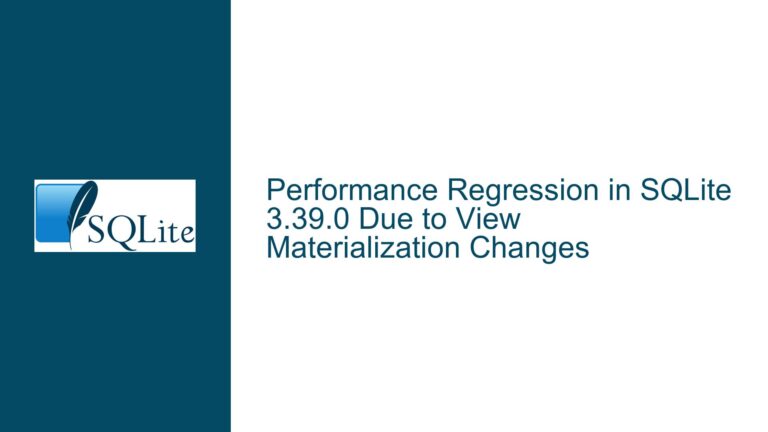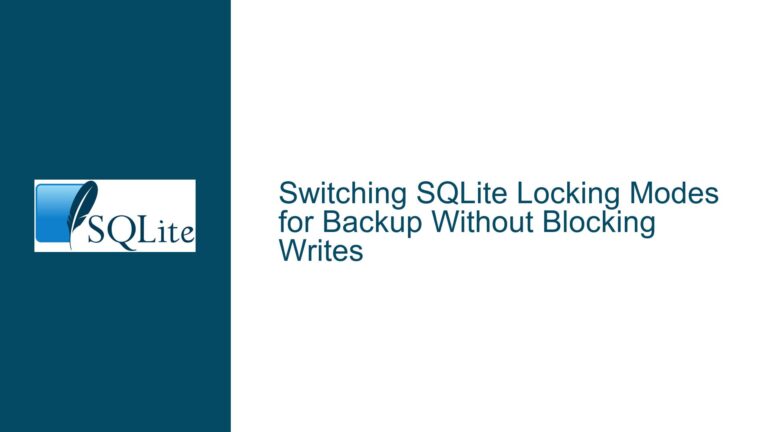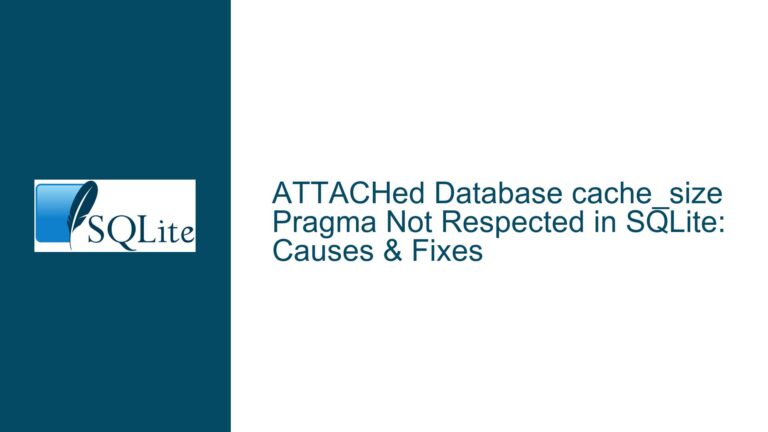Memory Error Identification and Resolution in SQLite 3.38.0
Understanding Memory Error Manifestations in SQLite 3.38.0
Memory errors in SQLite 3.38.0 typically present as segmentation faults, heap buffer overflows, or use-after-free scenarios detected by memory sanitizers. These errors often surface during high-concurrency operations, complex query execution, or when handling large BLOB objects. The SQLite library manages memory through explicit allocation/release cycles using sqlite3_malloc() and sqlite3_free(), with specific attention to temporary memory pools and prepared statement caches. Memory corruption in version 3.38.0 may manifest differently depending on the operating system’s memory protection mechanisms—Linux systems might generate core dumps with stack traces, while Windows environments could trigger structured exception handling events.
Critical patterns include crashes during VACUUM operations, ALTER TABLE transformations, or when utilizing window functions with large datasets. Developers should monitor for error codes SQLITE_CORRUPT (11), SQLITE_MISUSE (21), or generic SQLITE_ERROR (1) that sometimes precede memory faults. The SQLITE_CONFIG_LOG callback can be configured to track memory allocation patterns, while the sqlite3_status() interface provides real-time metrics on memory usage through parameters like SQLITE_STATUS_MEMORY_USED and SQLITE_STATUS_PAGECACHE_OVERFLOW.
Memory pressure scenarios—such as operating in SQLITE_CONFIG_SINGLETHREAD mode with multi-threaded memory allocators—create unique failure vectors. Version 3.38.0 introduced optimizations to the query planner that changed how subquery materialization uses temporary storage, potentially exposing latent memory management issues in applications that previously operated without error. The use of extension functions written in C that improperly handle sqlite3_value objects across aggregate boundaries represents another risk factor, particularly when combining custom virtual tables with SQLite’s built-in analytic functions.
Root Causes of Memory Management Failures in Recent SQLite Releases
Improper transaction scope management frequently underlies memory leaks in SQLite 3.38.0. Applications that begin explicit transactions using BEGIN but fail to COMMIT or ROLLBACK may leave statement handles active, preventing the release of associated memory resources. The introduction of strict typing in 3.37.0 altered how SQLite manages type conversions in prepared statements, creating scenarios where implicit casting operations generate temporary values that bypass normal cleanup routines.
Memory fragmentation in the page cache becomes problematic when applications rapidly attach/detach databases using ATTACH DATABASE with varying schema structures. Each attachment creates separate page cache regions, and improper sequencing of DETACH commands can leave orphaned memory blocks. The write-ahead log (WAL) mode introduces additional memory pressure through its wal-index shared memory mapping—incorrect mmap configurations on POSIX systems or file locking race conditions may corrupt these memory regions.
Extension modules that implement virtual tables or custom SQL functions must adhere strictly to SQLite’s memory ownership rules. A common failure occurs when extensions call sqlite3_free() on memory obtained from sqlite3_column_blob(), violating the API contract that such pointers remain valid until the next call to sqlite3_step() or sqlite3_reset(). Version 3.38.0’s enhanced query optimizer may reuse prepared statement objects more aggressively than prior versions, exacerbating use-after-free bugs in code that caches statement handles beyond their natural lifecycle.
Configuration mismatches between SQLITE_ENABLE_MEMSYS3 and SQLITE_ENABLE_MEMSYS5 compile-time options can create allocator conflicts, especially when linking against system-supplied SQLite libraries while assuming alternate memory management backends. The default memory allocator’s behavior changes significantly when SQLITE_CONFIG_HEAP is used to specify a static memory pool—incorrect size calculations for the heap boundary parameters often lead to silent memory corruption that surfaces during complex joins involving multiple common table expressions.
Comprehensive Diagnostic and Remediation Methodology for SQLite Memory Faults
Begin by isolating the failure context using SQLITE_DEBUG compile-time options. Enable the SQLITE_MEMDEBUG wrapper to detect buffer overruns and double-free conditions through memory poisoning and guard zones. Configure the error log callback via sqlite3_config(SQLITE_CONFIG_LOG) to capture internal SQLite warnings before they escalate to critical failures. Reproduce the issue while running under Valgrind’s memcheck tool or AddressSanitizer to identify invalid memory accesses—ensure the SQLite library is compiled with -DSQLITE_ENABLE_MEMSAN for precise instrumentation.
Examine prepared statement lifecycle management. All sqlite3_stmt objects must be finalized using sqlite3_finalize() even after execution errors. Implement wrapper functions that enforce statement reset and rebind protocols, particularly when reusing statements across different database connections. For applications using the multi-thread threading mode, verify that memory-intensive operations like backup API usage or incremental BLOB I/O are properly serialized through mutexes.
Review all custom extensions for compliance with SQLite’s memory ownership policies. Functions returning allocated memory must use SQLITE_TRANSIENT for parameters that cannot be retained beyond the function call duration. When implementing virtual table xBestIndex methods, ensure that constraint and column usage masks are properly initialized to prevent buffer overreads during query planning.
For database files exhibiting corruption symptoms post-memory error, run PRAGMA integrity_check and PRAGMA quick_check to assess structural validity. If errors appear in WAL-mode databases, attempt recovery using the .recover command in the SQLite CLI tool followed by VACUUM. Consider migrating critical data operations to memory-backed databases using sqlite3_deserialize() while troubleshooting persistent file-related memory issues.
Upgrade to SQLite 3.38.1 or later after verifying that the specific memory errors were addressed in subsequent patch releases—the SQLite change log documents memory-related fixes with keywords like "memory leak" or "heap overflow". When patching isn’t immediately feasible, mitigate risks by reducing the page cache size (PRAGMA cache_size), disabling shared cache mode (PRAGMA shared_cache=OFF), and avoiding memory-intensive features like JSONB support or geopoly extensions until resolution.
For deep memory diagnostics, use the sqlite3_db_status() interface with SQLITE_DBSTATUS_LOOKASIDE_USED to monitor lookaside memory utilization patterns. Enable the SQLITE_CONFIG_PCACHE_HDRSZ option to validate page cache header integrity during query execution. When interfacing SQLite through language bindings like Python’s sqlite3 module or Java’s JDBC, ensure native memory pressure isn’t being exacerbated by garbage collection delays in the host language’s runtime.
Persistent memory faults may require bisecting SQLite versions between 3.37.0 and 3.38.0 to identify the specific commit that introduced regression. Cross-reference findings with the SQLite forum’s memory error archives and consider submitting minimized test cases to the SQLite consortium for official analysis. For enterprise-scale deployments, implement continuous SQLITE_SOURCE_ID monitoring to detect version drift across instances that might mask memory management inconsistencies.






